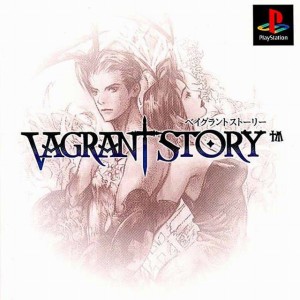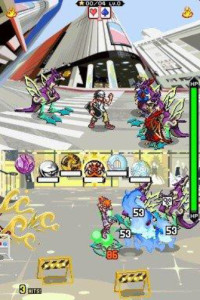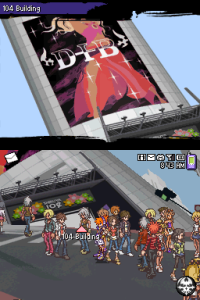As I write this, I’m sitting on a plane heading back from MAGfest 13. It’s a rather lengthy flight from the DC metro area to San Francisco – a little over five hours – so of course I came equipped with entertainment. Last week, Square-Enix released a new batch of non-Final Fantasy DLC for Theatrhythm, including some songs from Chrono Trigger and The World Ends With You, which I promptly acquired to accompany me back on my trip to the West Coast.
One of the DLC tracks from TWEWY is “Calling,” a theme that plays primarily during exploration and dialogue sequences. It’s a beautiful song, and I was very eager to play it1. What I wasn’t prepared for was an unexpected flood of emotion through me as I ran through it. As focused as I was on carefully gliding my stylus through the note barrage, I felt an intense longing hearing that music again.
But why? After all, back when I played The World Ends With You in 2008, I really enjoyed the game – but I hate, hate, HATED the ending, which I felt was an utterly stupid and transparent twist that undermined a great story concept. It made me bitter towards a game I had invested a great deal of time and emotion into. Yet hearing Calling stirred something inside of me. It made me realize what, exactly, makes TWEWY so very special: it’s a risky game that challenges players to do new things, to step outside their gameplay and setting comfort zones. And frankly, I don’t know if we’ll ever see something like it from Square-Enix ever again.
It’s quite odd that more than a decade post-merger, you can still separate Square-Enix’s software output into “Square Games” and “Enix Games.” Besides Dragon Quest – a franchise that’s built on a sense of tradition and familiarity – Enix was always the company more willing to try weird and unusual things: the Bust-a-Move series, early Tri-Ace titles that pushed JRPG conventions into strange territory, and really puzzling obscurities like Nanatsu Shima no Monogatari and Super Galdelic Hour. To me, stuff like NieR and Drakengard still feels very much like the Enix of old. Square, meanwhile, was always far more risk-averse: even when they branched further outside of their bread-and-butter RPGs in the PSOne era, the stuff they made always felt like it was trying to mimic other successful things on the market rather than make daring strides in gameplay design.2 The riskiest (pun not intended) title from Square of this time was doubtlessly Vagrant Story, an extremely demanding game which is both beloved and loathed by many.
In the period during- and post-merger, you really started to see less and less of the Enix-style risks in the new firm. Drakengard’s a good example: the first game is an unflinchingly dark story about terrible characters in a horrible world, while the second is just typical JRPG dullness. Tri-Ace’s output became considerably blander, almost as if there was some publisher interference.3 We started seeing direct sequels to numbered Final Fantasies – a true sign of risk aversion. Final Fantasy XII, which was set to be Matsuno’s magnum opus, was considerably stripped down and “softened” somewhat from his ambitious original concepts. (Not that it wasn’t spectacular, but it could have been a truly defining RPG for the next generation onward.)
That’s why The World Ends With You is so damned unusual among Square’s output of the time. Set in modern-day Shibuya, TWEWY touches on themes of youthful dissatisfaction and the common urban-living feeling of being surrounded by people, yet feeling lonely and isolated. Traditional JRPG gameplay elements are thrown out the window: the area of Shibuya you can explore is small yet very congested, much as it is in reality, while the combat utilized two characters operating on their own on each of the DS’s twin screens. Restricting exploration and combat with a steep learning curve might not sound like positives, but within TWEWY’s context, they work beautifully. The combat, in particular, is one of my favorite elements, acting as an exceptional challenge of coordination that is at first frustrating but evolves into an immensely satisfying test of skill. The heavy emphasis on Shibuya street and fashion culture, popular as it is, is highly unusual in a game context, and the story’s primary focus on individual characters and their growth throughout is a refreshing change from dire world-ending RPG scenarios. All things considered, the only really “safe” thing about TWEWY is the familiar Tetsuya Nomura character designs.
So what has Squeenix released since that’s been as risky? Last Remnant, maybe, since it was unusual for Japan to use the Unreal Engine at the time – though I strongly suspect that game began life as a SaGa title that was rebranded because of SaGa’s poor western reception. It could be argued that Final Fantasy XIII dared to change up a lot of Final Fantasy traditions, but really, FF13 was just looking at the AAA market trends and mimicking them. You have lots of lavish cutscenes, gameplay doled out in carefully constructed chunks, and a primarily linear experience punctuated by big bombastic setpieces – does this all sound familiar? Yes, FFXIII tried to be a modern AAA title rather than a Final Fantasy game in order to make it safer to a global audience – which is where it fumbled, because it turns out that really isn’t what people wanted out of FF. Bravely Default is more of a return visit to familiar traditional JRPG trapping with some modern design conceits… albeit a visit where a massive blizzard hits when you’re supposed to go home and you’re stuck there for another three days.
Looking over everything, NieR is probably the only other recent Squeenix title that’s just as daring and experimental as TWEWY, and that’s exactly why I love it so. Even Drakengard 3, as lovably weird and janky as it is, has a franchise behind it.
The reason why I suddenly feel so strongly about this game, I’m sure, is because I’ve realized that we’re not likely to see another game like this from Squeenix – hell, from most publishers – ever again. TWEWY seemed to sell well enough (though hardly Final Fantasy numbers), but while the characters have appeared in other games, a proper TWEWY sequel has yet to materialize, and honestly, I think I’m OK with that. After the iOS port of TWEWY removed a lot of the more interesting gameplay elements, I fear that a TWEWY2 would be shaped into something far more mass-market friendly, gameplay-wise, than the original. I realize we’re an industry built of sequels, but there are cases where I feel sequels simply aren’t necessary, and this is certainly one of them.
TWEWY is the type of game I love most. It tries interesting things and it doesn’t always succeed (like that awful ending), but I appreciate it all the more for actually making that attempt instead of being a design-by-committee title that you barely remember once it’s over and done. I hope that, someday, the Square side of Squeenix will actually have the guts to attempt something like this once again. I know I’ll be eagerly waiting to play it.
- The other TWEWY song is Twister, and unfortunately, it’s the worst version of that particular piece. Can’t win ‘em all, I guess. ↩
- It could be argued that Square took its biggest risk on The Spirits Within, of course, but I personally think at that point the execs at Square and Sony were too drunk on their own hype to even consider that it could fail. ↩
- I’m not saying for sure that there was, but it does seem odd that most of Tri-Ace’s best post-PSOne games were published by Not Squeenix. ↩



